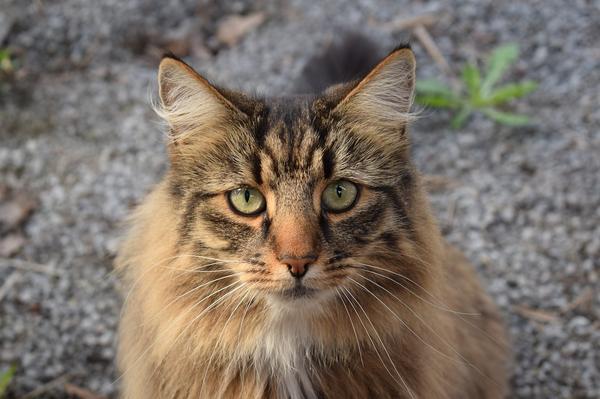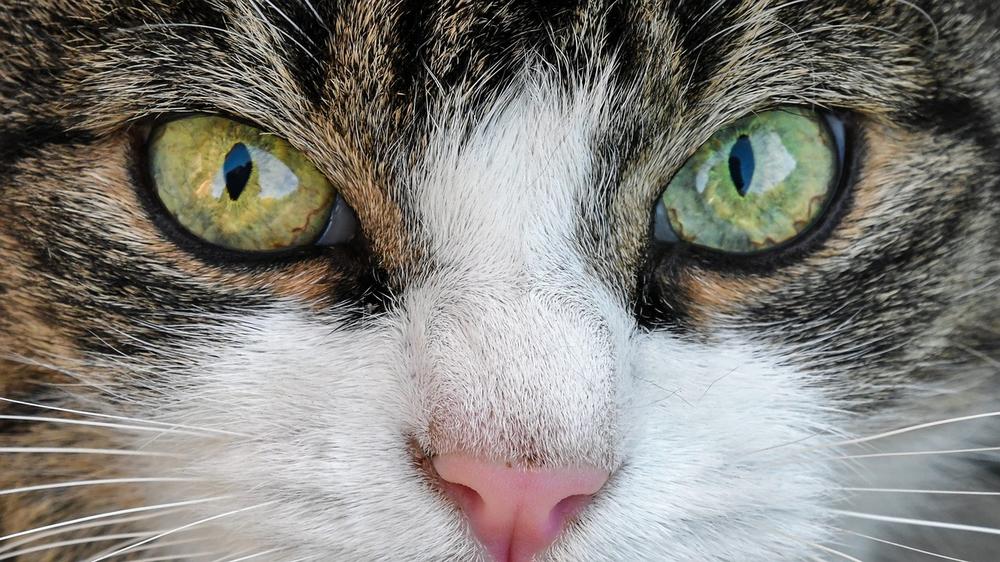Why Do Cats Have Wet Noses? (This Is the Scientific Explanation)

Curious about why cats have wet noses?
Intrigued by their unique physiology? 😺
Wonder no more...
Ever wondered, "What's the deal with those wet kitty noses?"
Let's dive right in and discover the truth together.
Time to unravel this feline mystery!
The Connection Between a Wet Nose and a Healthy Cat
While a wet nose on a cat can be cute, it's not always a sign of good health. Excessive wetness or discharge could indicate a respiratory infection. However, it's normal for a cat's nose to change from wet to dry throughout the day. Keep an eye out for any persistent wetness or unusual discharge and consult a vet if needed.
Cats with wet noses look cute and healthy, right?
That's not always the case.
Excessive wetness or discharge from your cat's nose can be a red flag. It may indicate a respiratory infection or some other health problem you definitely don't want to ignore.
But wait, there's more!
A wet nose isn't necessarily a sign of illness. It's totally normal for cats to have wet noses that change throughout the day.
They can go from wet to dry and back again in a flash.
It's just part of their natural cycle.
Now, here's what you need to do...

If you notice persistent wetness or strange-colored discharge from your feline friend's nose, that’s cause for concern. Make sure to consult your vet for professional advice.
And bear in mind this important tip:
Cats love cleanliness!
Maintain a clean living space to reduce the chances of infections and illnesses.
Always observe your cat closely.
If you see any unusual symptoms, don't hesitate to reach out to your veterinarian.
Keeping your furry friend healthy is your top priority!
Main points I'll expand upon further down this article:
- Wet noses in cats enhance their sense of smell.
- Cats have a scent gland called the Jacobson's Organ.
- Licking their noses helps reset and remove residue.
- Cats with wet noses can more easily detect different smells.
- A cat's nose is essential for exploring its environment and finding prey.
- Wet noses in cats are mainly due to sweat glands and tear ducts.
- Wetness on a cat's nose helps regulate their body temperature.
- Catnip can stimulate tear ducts or nasal glands, making a cat's nose moist.
- Fluctuations in a cat's nose wetness can occur throughout the day.
- Any abnormal appearance or discharge from the cat's nose should be monitored and may require veterinary attention.
Now, here's the deal...
Have you ever wondered how exactly a cat's nose helps them detect scents and communicate with other cats?
Well, get ready to be amazed because the next section dives deep into the fascinating world of the Jacobson's Organ and its role in a cat's olfactory prowess.
Trust me, it's mind-blowing!
The Wet Noses of Cats: Fine-tuning Smelling Abilities
Cats don't just sport wet noses for cuteness, there's actually a scientific reason behind it that directly impacts their sense of smell.
Let me break it down for you...
First off, cats possess something called the Jacobson's Organ, which plays a crucial role in detecting pheromones and aiding their communication with fellow felines and potential partners.
But that's not where it ends...
Their wet noses also play a key role in fine-tuning their smelling abilities. How so?
Well, cats have this intriguing thing called the flehmen response. To get a better whiff of scents, they breathe through their mouths and keep them open.
And guess what?
The moisture on their noses grabs hold of scent particles, helping them identify various smells.
And here's another fascinating tidbit for you...
When cats lick their noses, it serves two purposes.
Firstly, it removes any lingering residue, ensuring a clean slate for their sense of smell. Secondly, whether a cat's nose is naturally drier or warmer, the presence of moisture aids in fulfilling its intended function.
Now brace yourself for a mind-blowing statistic - cats boast approximately 200 million scent receptors!
Yes, you heard me right.
Their noses are insanely important!
These scent receptors enable cats to navigate their surroundings, locate prey, determine safe food options, and recognize fellow felines.
So the next time you catch your furry friend sporting a wet nose, remember that it's an integral part of their remarkable olfactory capabilities.
Take it or leave it: The fascinating topic of cats' wet noses doesn't stop here. If you keep reading further down the blog post, I'll share some valuable information about warning signs when a dry nose turns wet and drippy.
Well, I bet you didn't know that the moisture on a cat's nose does more than just enhance their sense of smell... In fact, it plays an important role in other fascinating aspects of their lives.
So, let me dive deeper and reveal some intriguing secrets about why cats have wet noses and how it affects them.
You won't believe what I'm about to tell you!
The Role of Moisture in a Cat's Nose
Moisture in a cat's nose serves multiple purposes. It acts as a magnet for scent particles, enhances their sense of taste, helps cool them off, and can come from drinking water, tears, or grooming. Cats' wet noses quickly evaporate, and licking their nose helps regulate body temperature.
The role of moisture in a cat's nose is not just some weird quirk.
It actually serves a purpose, and that's what we're gonna talk about today.
In fact, the wetness on a cat's nose has multiple functions that go beyond just making them adorable.
First off, it helps cats to attract scent particles.
That wet surface acts like a magnet, drawing those odor molecules right in.
But wait, there's more.
The moisture also plays a role in enhancing their sense of taste.
When food comes in contact with a cat's wet nose, it dissolves those tasty molecules, giving them a better idea of what they're about to gobble up.
Now let's get into the nitty-gritty of why cats have wet noses.
It all boils down to those small sweat glands located on the rhinarium, which is the fancy term for the hairless area around the nostrils.
These glands release sweat, adding moisture to the nose.
Additionally, your furry friend's wet nose can also be caused by tears that drain from their tear ducts. Yep, cats cry too!
Not only that, but cats use their wet noses for a bit of evaporation action.
You see, when cats are feeling hot under the collar, or should I say fur, the moisture on their noses helps cool them off as it evaporates.
So, where does all that wetness come from?
Well, it could be from drinking water, playing in the rain or snow, or even from grooming themselves. Sometimes, excess tears find their way into the nasal cavity, making that little nose all wet and shiny.
And let's not forget about catnip. This herb might not make cats cry, but it sure does stimulate their tear ducts and nasal glands, resulting in a moist nose.
That wet nose won't stay wet forever.
Thanks to quick evaporation, especially in humid environments, cats can go from wet to dry in a jiffy.
And if you happen to catch your feline friend licking their nose, don't be surprised.
They might just be grooming or using that slick move to regulate their body temperature.
So, now you know the scoop on why cats have wet noses.
Isn't it fascinating how something as simple as a wet nose can serve multiple functions?
Cats sure are full of surprises!
But what about when a cat's nose is overly wet or runny?
Could it be a sign of something more serious?
Buckle up, because in the next section, we'll explore the red flags to look out for and when it might be time to seek veterinary attention...
Warning Signs: When a Dry Nose Turns Wet and Drippy
Fluctuations in temperature and moistness of a cat's nose
You know, a cat's nose can change throughout the day.
Sometimes, their noses might feel wet and drippy, while other times they may be dry.
Before you start worrying about your furry friend, you must think about things that are happening around them, like how hot or humid the environment is.
These changes in their nose don't necessarily mean anything is wrong.
Pay attention to accompanying signs and behavior changes
But, if you notice some extra signs along with a dry or wet nose, then it’s time for concern.
If your cat seems overly thirsty, isn't eating as much, losing weight, throwing up, or having diarrhea, those are all possible signs that something isn't right.
Your feline buddy might have an underlying health issue going on, so you ought to get help from a veterinarian as soon as possible.
But hold on, there's more!
You also need to pay attention to any changes in behavior or actions. If your cat's nose looks strange or different, it could mean they have a cold, allergies, an infection in their upper respiratory system, scratches, or even growths.
Don't ignore these warning signs!
Make sure to reach out to a vet if you see any of these symptoms.
Different types of nasal discharge
Now, let's talk about what happens when a cat's nose is running.
A little bit of clear snot is normal, but if it becomes bubbly, thick, yellow, green, or black, it's definitely time to take action. These colors can indicate an infection or illness, so don't hesitate to visit the vet if you notice them.
Moreover, excessive licking caused by a runny nose can make their snout dry, rough, and irritated.
Keep an eye on your furry baby and provide them with the care they need to keep their noses healthy and happy.
Moreover, if you're curious about whether it's safe to show affection by kissing your cat on the nose, I highly recommend checking out my article Is It Safe to Kiss Your Cat on the Nose.
In it, you'll find all the essential information and guidelines to determine if this gesture is suitable for your furry friend.
Don't miss out on this valuable resource to ensure the health and happiness of your beloved cat.
Common Cat Nose Ailments
Cats, like humans, can suffer from various nose ailments.
- Foreign objects lodged in their nostrils can cause nasal congestion and discomfort for cats. Keep an eye out for any unusual discharge or behavior in your cat's breathing.
- Respiratory infections are another common cause of nasal congestion in cats. Look out for sneezing, coughing, or a runny nose.
- Hairless cats with white fur and pink noses are prone to sunburn, which can result in skin flaking on their noses. Protecting them from the sun is essential.
- If your cat experiences congestion and wheezing, it might be an indication of a more serious respiratory issue that requires veterinary attention.
- Flaking skin on the nose could also signal a dermatological issue, and it's recommended that you have your vet examine your cat's nose.
- Considering pet insurance can help manage potential costs associated with your cat's medical care, including treatment for nose ailments.
Monitoring your cat's breathing and seeking veterinary attention when necessary is crucial for ensuring their well-being. 😺
And by the way, did you know that a cat's wet nose plays an important role in their overall health and well-being?
In our next section, we will explore the fascinating scientific reasons behind why cats have wet noses.
Get ready to uncover the secrets behind this feline phenomenon...
How to Care for Your Cat's Nose
Taking care of your cat's nose is important for their all in all health and well-being. 🐱

Here are five tips to help you out:
- Gently clean their nose with a moist cloth to get rid of any debris or discharge, without irritating their sensitive skin.
- Make sure they always have access to clean and fresh water. Cats need to stay hydrated, especially if they mainly eat dry food.
- Include canned cat food in their diet as it has a high moisture content. This will increase their fluid intake and keep their noses hydrated.
- Don't use human sunscreen on their nose. Look for pet-friendly alternatives or provide shade when exposing them to sunlight.
- Keep an eye out for dehydration signs like increased thirst, dry gums, and decreased skin elasticity. If you see these symptoms, contact your vet.
Your furry friend's nose will remain in good health and they'll be filled with joy if you adhere to these suggestions!
And that wraps up today's article.
So you're here, at the end of my blog post! I was wondering, did you enjoy it? I always put in a ton of effort to make my blog posts as helpful and detailed as possible. It takes quite a bit of time, but in a rewarding way. It would mean a lot to me if you could share this post with others by clicking on any of the social sharing icons. Thank you so much for your support!
Talk soon,
-Sarah Davis